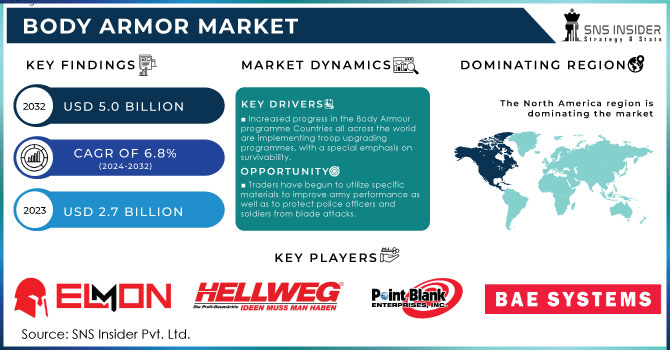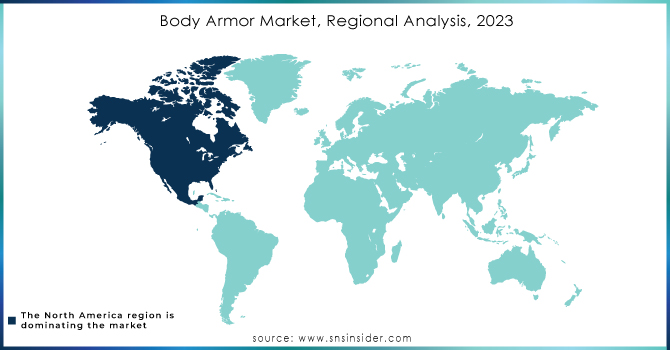Body Armor Market Report Scope & Overview:

To get more information on Body Armor Market - Request Free Sample Report
The Body Armor Market Size was valued at USD 2.7 billion in 2023 and is expected to reach USD 5.0 billion by 2032 and grow at a CAGR of 6.8% over the forecast period 2024-2032.
Body armor is a form of protective textile whose primary function is to absorb or deflect slashing bludgeon and penetrating assaults. It was once exclusively licensed for use by the military, but it is now utilized by police, security guards, and individuals to feel comfortable and protect themselves from attacks.
Body armor is classified into two types: soft body armor and hard body armor. Body armor is classified according to its capacity to stop projectiles. Body armor is classified into two types. International standards are established by the National Institute of Justice (NIJ), whilst UK standards are established by the Home Office Scientific Development Branch.
MARKET DYNAMICS
KEY DRIVERS
-
Increased progress in the Body Armour programme Countries all across the world are implementing troop upgrading programmes, with a special emphasis on survivability.
-
Many countries are currently investing in body Armour and other personal protection equipment for their military forces.
OPPORTUNITY
-
Traders have begun to utilize specific materials to improve army performance as well as to protect police officers and soldiers from blade attacks.
CHALLENGES
-
There is a scarcity of body Armour and personal protective equipment.
-
Reduced weight of body Armour without sacrificing quality is another difficulty that body Armour is facing these days.
Level IV body Armour plate led the market for body Armour plates in 2021 with a revenue share of more than 25.0%. This segment is expected to grow at a significant rate throughout the forecast period. This increase is because the final edition of NIJ Standard 0101.07 is expected to improve test techniques and performance standards for ballistic resistance levels. In addition, the new NIJ standard is expected to include additional threat levels for rifle protection. The increased vulnerability to rifle protection levels should contribute to the growth of the level IV Armour plate.
The market is divided into four applications: defense, law enforcement protection, civilians, and others. Body Armor Plates are most commonly used in the defense industry. Body Armor Plates are being used by defense forces to avoid casualties from terrorist operations and militant violence as global tensions rise. Law Enforcement Protection employees are exposed to a variety of hazards that might cause severe harm to the human body. Thus, body Armour plates aid in the prevention of harm and provide additional protection for law enforcement officers.
These authorities face danger during city protests, domestic violence, and other circumstances. In the event of a protocol violation, protection shields come in helpful to avert pandemonium during a civic demonstration. Body Armor plates are not just for military people. Civilians can also use the body Armour plates if they feel the need to. There is also a noticeable increase in civilian demand for protective shields, which contributes to the global Body Armor Plates Market's growth.
The market is classified into UHMWPE, Steel, Aramid, Composite Ceramic, and Others. UHMWPE is an Armour manufactured by attaching Ultra High Molecular Weight Polyethylene Fibers to a sheet of High-Density Polyethylene. These sheets are placed in Moulds and trimmed to shape. These sheets are then subjected to tremendous pressure and heat, which fuses them into a cohesive hard Armour plate. Steel body Armour plates are constructed of steel and protect the body from external threats such as bullets. Aramid plates are made up of heat-resistant fibers with a strong synthetic origin. They are employed in ballistic-rated body Armour.
Through their great hardness and compressive strength, composite ceramic plates are developed for armored vehicles and personal Armour to prevent projectile object penetration. The soft Armour segment led the market, accounting for 45% of global sales. The large share can be attributed to the fact that soft shields, due to their lightweight characteristics, are regarded as appropriate for vocations where flexibility and comfortable mobility are essential. Soft Armour, Soft Armour is popular among military troops since it is less in weight. Soft Armour also provides significant protection against combat risks such as ballistic bullets and pieces from explosions.
Demand for armor is likely to rise as technology advancements and modernization initiatives encourage security agencies and armed units to purchase cutting-edge equipment. When opposed to soft Armour, hard forms are typically heavier and thicker. It has plates made of titanium, steel, or ceramic that can withstand high-caliber bullets. It also provides a better level of protection than the softer product types. Furthermore, due to the growing popularity of helmets bulletproof bags, and backpacks, the accessories segment is predicted to develop at the fastest CAGR of 6.0%.
The overt category led the market, accounting for more than 85 percent of global revenue. The high proportion can be linked to Kevlar's use of overt body armors, which provide greater protection from huge spikes/blades and heavy gunfire. Overt body armors are worn on top of clothing and are frequently larger and heavier due to the use of many Kevlar layers. Furthermore, covert body armors are predicted to grow at a significant CAGR of 5.8% during the forecast period. This expansion can be attributed to the growing demand for lightweight body armor with superior ballistic protection.
KEY MARKET SEGMENTATION
By Application
-
Defense
-
Law Enforcement Protection
-
Civilians
-
Others
By Material
-
Steel
-
Aramid
-
Composite Ceramic
By Level
-
Level IIA
-
Level II
-
Level IIIA
-
Level III
-
Level IV
By Product Type
-
Soft Armor
-
Hard Armor
-
Accessories
By Product Style
-
Covert
-
Overt
REGIONAL ANALYSIS:
In 2021, North America will have the greatest market. Government military operations such as the Soldier Protection System-Torso and Extremity Protection (SPS-TEP) for providing full-body armour to soldiers are likely to stimulate regional market growth. Furthermore, increased military spending in nations such as Canada and the United States has boosted regional market growth.
Due to escalating border and wartime disputes in nations such as China, South Korea, and India, the Asia Pacific region has been identified as a prospective growth market in recent years. Rising government spending on the defence sector for arms and defence equipment is also predicted to benefit the market.

Need any customization research on Body Armor Market - Enquiry Now
REGIONAL COVERAGE:
-
North America
-
USA
-
Canada
-
Mexico
-
-
Europe
-
Germany
-
UK
-
France
-
Italy
-
Spain
-
The Netherlands
-
Rest of Europe
-
-
Asia-Pacific
-
Japan
-
south Korea
-
China
-
India
-
Australia
-
Rest of Asia-Pacific
-
-
The Middle East & Africa
-
Israel
-
UAE
-
South Africa
-
Rest of Middle East & Africa
-
-
Latin America
-
Brazil
-
Argentina
-
Rest of Latin America
-
KEY PLAYERS
The Major Players are Elmon SA, Ceradyne, Inc., Hellweg International, Point Blank Enterprises, Inc., Safariland, LLC, BAE Systems, Ballistic Body Armor Pty, Craig International Ballistics Pty Ltd., Kejo Limited Company, Pacific Safety Products, and other players.
| Report Attributes | Details |
|---|---|
| Market Size in 2022 | US$ 2.7 Billion |
| Market Size by 2030 | US$ 5.0 Billion |
| CAGR | CAGR of 6.2% From 2024 to 2032 |
| Base Year | 2023 |
| Forecast Period | 2024-2032 |
| Historical Data | 2020-2022 |
| Report Scope & Coverage | Market Size, Segments Analysis, Competitive Landscape, Regional Analysis, DROC & SWOT Analysis, Forecast Outlook |
| Key Segments | • By Application (Defense, Law Enforcement Protection, Civilians, Others) • By Material (Steel, Aramid, Composite Ceramic) • By Level( Level IIA, Level II, Level IIIA, Level III, Level IV) • By Product Type(Soft Armor,Hard Armor, Accessories) • By Product Style(Covert, Overt) |
| Regional Analysis/Coverage | North America (USA, Canada, Mexico), Europe (Germany, UK, France, Italy, Spain, Netherlands, Rest of Europe), Asia-Pacific (Japan, South Korea, China, India, Australia, Rest of Asia-Pacific), The Middle East & Africa (Israel, UAE, South Africa, Rest of Middle East & Africa), Latin America (Brazil, Argentina, Rest of Latin America) |
| Company Profiles | Elmon SA, Ceradyne, Inc., Hellweg International, Point Blank Enterprises, Inc., Safariland, LLC, BAE Systems, Ballistic Body Armor Pty, Craig International Ballistics Pty Ltd., Kejo Limited Company, Pacific Safety Products, and other players. |
| DRIVERS | • Increased progress in body Armour program Countries all across the world are implementing troop upgrading program, with a special emphasis on survivability. • Many countries are currently investing in body Armour and other personal protection equipment for their military forces. |
| OPPORTUNITY | • Traders have begun to utilize specific materials to improve army performance as well as to protect police officers and soldiers from blade attacks. |

